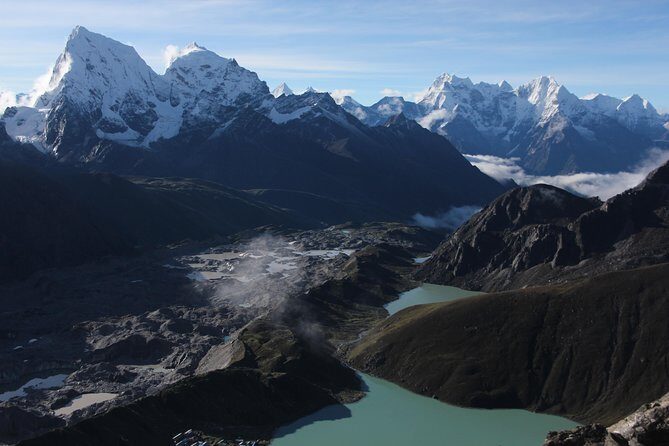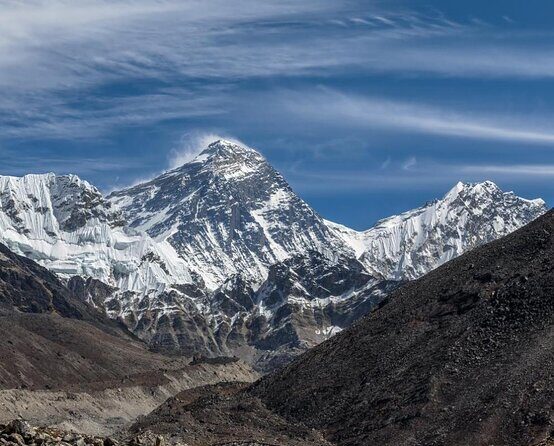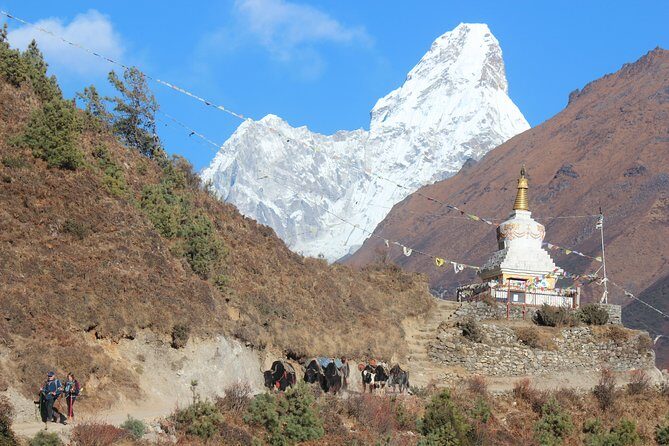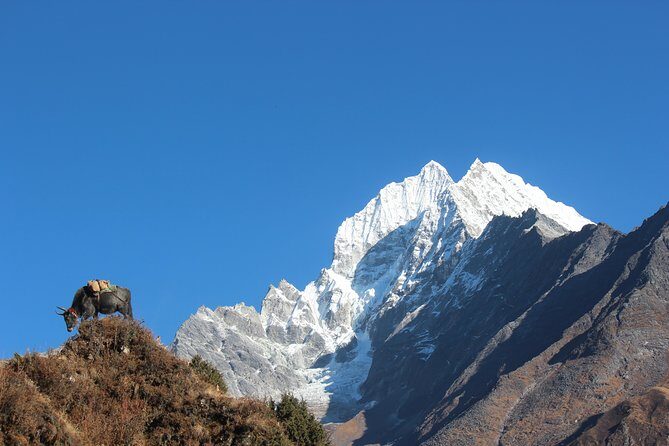Physical Address
304 North Cardinal St.
Dorchester Center, MA 02124
Physical Address
304 North Cardinal St.
Dorchester Center, MA 02124

Experience the thrill of the Everest Three Pass Trek, a challenging 15-day adventure with stunning Himalayan views, expert guides, and authentic Sherpa culture.
Tackling the Everest Three Pass Trek is no small feat. This 15-day journey offers an intense blend of breathtaking scenery, rugged terrains, and high-altitude challenges. It’s designed for seasoned trekkers who crave adventure and are prepared for the physical and mental demands of crossing three formidable passes—Kongma La, Cho La, and Renjo La.
One of the things we especially love about this trek is how it takes you beyond the crowd to experience a more authentic side of the Everest region. From crossing icy passes to witnessing stunning mountain panoramas and exploring Sherpa villages, every step feels meaningful. A potential drawback? The physical toll is significant, so this trek isn’t for the faint-hearted. It’s best suited for those with good fitness levels and a love for adventure, eager to challenge themselves while soaking in some of the world’s most awe-inspiring scenery.
If you’re looking for a trek that combines adventure, cultural insights, and jaw-dropping views, this tour hits all those marks. It’s perfect for experienced hikers wanting to push their limits and truly get off the beaten path in Nepal’s Himalayas.

Looking for more options in Kathmandu? Here are some other experiences worth considering.
Your adventure begins with an early morning flight from Kathmandu to Lukla, often called one of the most scenic commercial flights worldwide. Expect views of lush hills, snow-capped peaks, and dramatic valleys from above. Upon landing, you’ll meet your crew, including a licensed English-speaking guide, porters, and support staff, ready to start your trek.
Lukla is famously busy with trekkers and porters, but it’s a lively place to get your first taste of Himalayan life. The trek kicks off with a walk along Dudh Koshi River, crossing several suspension bridges adorned with prayer flags—an experience that immediately immerses you in Sherpa culture and the mountain environment.
Your route follows the river to Phakding, then ascends to Namche Bazaar, the bustling hub of the region. The hike to Namche is a highlight, with lush rhododendron forests, mountain vistas, and Sherpa villages along the way. Once in Namche, you’ll want to relax and acclimate—most reviews highlight the importance of rest days here.
We loved the way guides like Shiva and others shared stories about Sherpa traditions, making the trek more meaningful. In fact, reviewers frequently mentioned how guides go beyond just navigation—they explain cultural nuances, nature facts, and mountain legends.
On your rest day, you can hike up to the Everest View Hotel for incredible vistas of Nuptse, Thamserku, Ama Dablam, and Everest itself. We particularly appreciated the visit to Khumjung and its monastery, where the display of the Yeti skull adds a quirky touch to the Sherpa’s legendary tales.
From Namche, the path continues upward through Tengboche, home to the iconic monastery with panoramic views of the Himalayas. The scenery is mesmerizing, especially when you pass Ama Dablam and Lhotse. The trail ascends further to Dingboche, a picturesque village surrounded by striking mountain peaks like Lhotse (8,414m) and Ama Dablam.
A clever move by many trekkers is to skip an extra rest day here by heading directly to Chhukung, which helps prepare for the passes ahead. The route along Imja River offers mesmerizing vistas and the chance to see glaciers and snowfields.
This trek’s crown jewels are the three snow-covered passes. The first, Kongma La (5535m), is the highest point of the trek, demanding a steep climb on rugged, often icy terrain. The effort is hefty but rewarded with expansive views of Everest, Nuptse, and the surrounding peaks. As one reviewer beautifully put it, “the trail to Kongma La is steep uphill with some difficulties,” but reaching the summit offers a sense of achievement and awe.
Next is Cho La (5420m), which some travelers describe as “slippery” and requiring crampons. It’s a challenging crossing over a glacial terrain, but the views from the top—of Everest, Choyu, and Lhotse—are unforgettable. Descending into Gokyo Valley, you’ll pass Ngozumpa Glacier and arrive at the stunning Gokyo Lakes, a truly peaceful, otherworldly setting.
The final pass, Renjo La (5360m), offers spectacular views of Everest, Cho Oyu, and the Rolwaling range. The descent leads to the picturesque village of Lunden, where you can catch your breath and reflect on the journey.
From Gokyo, the trek leads to Gorakshep, the last stop before Everest Base Camp (EBC). After a tough but rewarding walk, you’ll stand at the foot of Everest, with close-up views of Nuptse, Khumbutse, and Pumori. Spending time at EBC, soaking in the atmosphere among climbers and snow, is an experience no trekker forgets.
Early the next morning, a challenging hike takes you up to Kala Patthar (5550m), offering possibly the best panoramic view of Everest. Many reviews mention the sunrise here—”spectacular” and “breathtaking”—as the first rays hit the summit of Everest, illuminating the surrounding peaks.
The trek then loops back through Dzongla, Namche, and Lukla, with the journey highlighting the changing scenery and the warmth of Sherpa hospitality. The final day concludes with a flight back to Kathmandu, where you can unwind and share stories of your high-altitude adventure.

The $1,800 price tag includes all essential permits, domestic flights, accommodations in comfortable guesthouses, and meals during the trek. Notably, the package covers the purchase of permits like the National Park entry and TIMS, which are mandatory for trekking in the region. Transportation between Kathmandu and Lukla is also included, removing the hassle of planning flights separately.
The guides, such as Shiva and others, are praised for their local knowledge, helpfulness, and safety consciousness. Many reviewers highlighted the organization and professional attitude of the team, making the journey smoother despite the logistical complexities of high-altitude trekking in the Himalayas.
Included in the package are a down jacket, sleeping bag, duffel bag, and all land transport, making packing easier. Meals—breakfast, lunch, and dinner—are provided, with reviews noting the delicious, hearty food that keeps trekkers energized.
However, travelers should be ready for additional expenses like personal gear, tips, drinks, laundry, and hot showers, which are not covered. Also, the trek demands a good level of physical fitness—many reviewers emphasize the difficulty of crossing passes and managing altitude.

Two reviewers emphasize the guides’ expertise and helpfulness, with Shiva and Jwala mentioned specifically for their professionalism and friendliness. “The guide was very helpful and explained us about the places while trekking,” one reviewer noted, highlighting the value of local knowledge.
Others praised the overall organization, with one saying, “Despite all challenges during the pandemic, it was handled admirably by everyone at Base Camp,” demonstrating reliable planning even under difficult circumstances. The guides also offer cultural insights and ensure safety, particularly on the icy, steep passes.
Many travelers found the trek to be “worth every cent,” citing the excellent value for the included permits, flights, accommodations, and meals. The stunning views and authentic experiences, combined with well-organized logistics, make this trek a memorable adventure.
The Everest Three Pass Trek is an exceptional route for experienced hikers eager to push their limits while soaking in some of the Himalayas’ most spectacular scenery. The combination of challenging passes, breathtaking vistas, and cultural encounters offers a deeply rewarding experience.
If you love adventure, have good physical fitness, and want to go beyond the typical Everest Base Camp trek, this journey is a fantastic choice. It provides a unique opportunity to see the mountains from different perspectives, cross icy passes, and learn about Sherpa hospitality—all with expert guidance and excellent organization.
This trek is best suited to seasoned trekkers looking for a demanding yet profoundly enriching experience. It’s for those who don’t mind long days of walking, high altitudes, and rugged terrain, but also appreciate the comfort of reliable logistics and knowledgeable guides to make it all feasible.

Is this trek suitable for beginners? No, this trek requires good physical fitness and acclimatization, as it involves crossing high passes and navigating rough terrain.
Are meals included during the trek? Yes, breakfast, lunch, and dinner are provided during the trek, and reviews mention that the food is delicious and energizing.
What is the main challenge of this trek? The high-altitude passes—Kongma La, Cho La, and Renjo La—are physically demanding and require careful acclimatization to avoid altitude sickness.
Does the package include flights? Yes, the price covers domestic flights from Kathmandu to Lukla and back, along with all necessary permits.
What kind of guides will I have? The guides are licensed, English-speaking, and highly knowledgeable about the region, culture, and safety procedures.
How long in advance should I book? On average, this trek is booked about 76 days before the departure date, so early planning is recommended.
The Everest Three Pass Trek offers an intense, rewarding adventure with unparalleled views and cultural insights. Perfect for seasoned climbers and explorers ready to go beyond the typical trail, it promises unforgettable memories amid some of the world’s highest peaks.